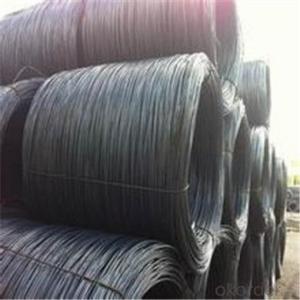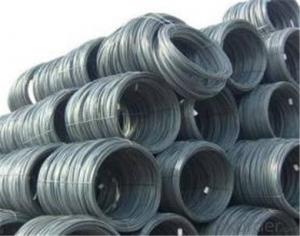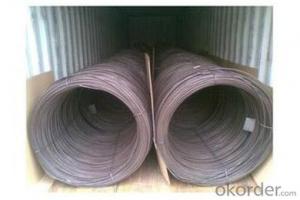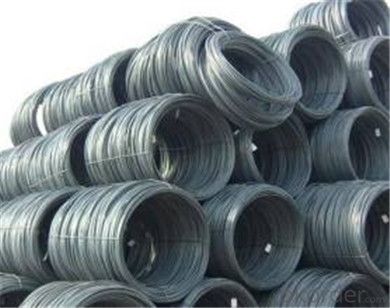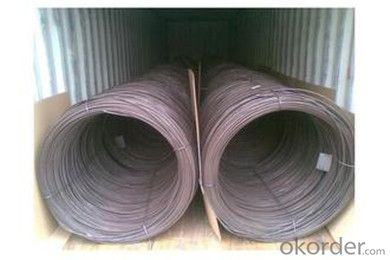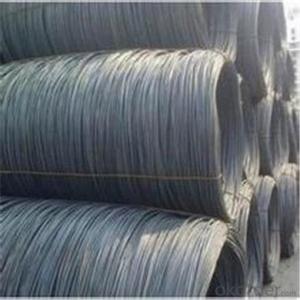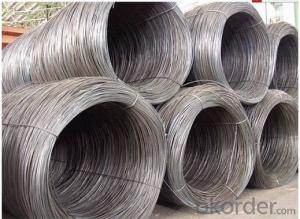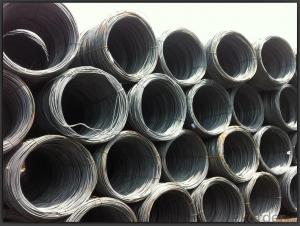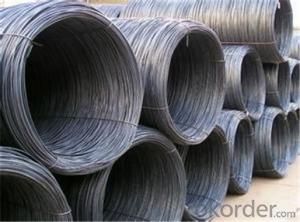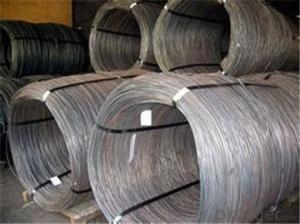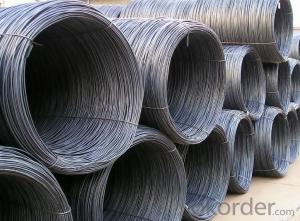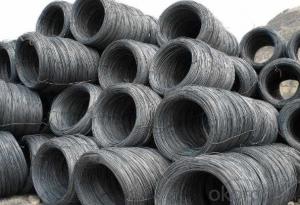SAE1006B Steel Wire Rod 6.5mm with Best Quality in China
- Loading Port:
- Tianjin
- Payment Terms:
- TT OR LC
- Min Order Qty:
- 200 m.t.
- Supply Capability:
- 45555555 m.t./month
OKorder Service Pledge
OKorder Financial Service
You Might Also Like
Specification
Description of wire Rod:
1. Drawn wire specialist, your wire rod solution
2. ISO9001 Certified Mill &SGS
3. Feature: machinability, high hardness, toughness, corrosion resistant
Festures of wire Rod:
1. Drawn wire specialist, your wire rod solution
2. ISO9001 Certified Mill &SGS
3. Feature: machinability, high hardness, toughness, corrosion resistant
4. Clear and smooth surface, high precision and Tolerance control: ± 0.01
Specifications of wire Rod:
Product | steel wire rod |
Standard | AISI, ASTM, BS, DIN, GB, JIS |
Material/steel grade | Q195-Q235,SAE1006, SAE1008, SAE1010, SAE1018, SAE1020 or according to customers requirements |
Wire Gauge | 5.5-12mm |
Coil weight | 1.8-2.1mts |
MOQ | 25MT |
Delivery Time | 15-30 days after receipt of L/C or deposit by T/T |
Packing | In coil and load in container, if large quantity, by bulk vessel; Can be packed as customers' special requirements |
Payment terms | 1).100% irrevocable L/C at sight. |
Application | widely used in machinery parts, manufacturing industry, electronics industry, metal tools and others |
Images of wire Rod:
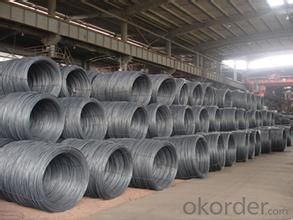
FAQ:
1. What is your package?
Packing situation: standard seaworthy packing or as customer required.
2. How long is the lead time?
Delivery time: 45 days after order confirmed.
3. What payment term do you accept?
Payment: T/T or L/C at sight.
- Q: How is steel wire rod used in the manufacturing of wire forms for signage?
- Wire forms for signage rely heavily on steel wire rod as a crucial element in their manufacturing process. The wire rod serves as the primary material for shaping and designing wire forms. To begin with, careful selection of the steel wire rod is based on its specific mechanical and chemical properties, such as tensile strength and resistance to corrosion. These properties guarantee the durability and ability of the wire forms made from the rod to withstand diverse weather conditions. Following the selection, the steel wire rod undergoes a series of manufacturing steps. Typically, the rod is drawn through a sequence of dies to reduce its diameter and increase its length. This wire drawing process enables the production of wires with precise dimensions and smooth surfaces. After achieving the desired thickness, the wire is further processed to create the specific shapes and forms required for signage. This may involve bending, coiling, or welding the wire into various configurations, depending on the design specifications. Once the wire forms are shaped using the steel wire rod, they are utilized in the manufacturing of signage. These wire forms often function as structural frameworks or supports for different types of signage, such as letters, logos, or decorative elements. They provide the necessary stability and rigidity to hold the signage in place, ensuring its integrity and visibility. Furthermore, the versatility of steel wire rod allows for the creation of intricate and complex wire forms that can be customized to meet specific design requirements. This design flexibility enables the production of visually captivating and distinctive signage, enhancing its aesthetic appeal and brand recognition. In conclusion, steel wire rod plays a vital role in the manufacturing of wire forms for signage. It serves as the raw material from which wire forms are shaped, providing the necessary strength and durability required for signage applications. The ability to customize wire forms allows for the creation of visually appealing and distinctive signage, making steel wire rod an indispensable component in the signage industry.
- Q: What are the common industry best practices for steel wire rod suppliers?
- Some common industry best practices for steel wire rod suppliers include ensuring quality control throughout the manufacturing process, adhering to international standards and certifications, maintaining efficient production and delivery systems, providing excellent customer service, and continuously improving product offerings and technology.
- Q: How does the diameter of steel wire rod affect its strength?
- The diameter of a steel wire rod directly affects its strength. Generally, a larger diameter wire rod will have higher strength compared to a smaller diameter wire rod. This is because a larger diameter rod has a greater cross-sectional area, allowing it to withstand higher loads and stresses without breaking or deforming.
- Q: How are steel wire rods used in the production of piano wire?
- Steel wire rods are used in the production of piano wire by being drawn through a series of dies to gradually reduce their diameter. This process, known as wire drawing, results in a long, thin, and high-tensile strength wire that is then coiled, hardened, and tempered to create the strong and resilient piano wire used in piano strings.
- Q: How does the quality of steel wire rod affect its performance?
- The quality of steel wire rod directly affects its performance as it determines its strength, durability, and resistance to wear and tear. Higher quality steel wire rod will have a more consistent and uniform composition, leading to improved mechanical properties such as increased tensile strength and flexibility. It will also exhibit better corrosion resistance, making it suitable for various applications in construction, manufacturing, and engineering industries. Conversely, lower quality steel wire rod may have impurities, irregularities, or inconsistent composition, resulting in reduced performance and potentially compromising the safety and reliability of the products or structures it is used in.
- Q: How is steel wire rod used in the manufacturing of wire for fishing nets?
- Steel wire rod is used in the manufacturing of wire for fishing nets as it serves as the primary material for creating the strong and durable wire that forms the net structure. The wire rod is first drawn through a series of dies to reduce its diameter and increase its tensile strength. This drawn wire is then twisted or braided together to form the individual strands that make up the fishing net. The resulting wire netting is capable of withstanding the tension and pressure exerted during fishing activities, ensuring the net's reliability and longevity.
- Q: What are the advantages of using steel wire rod over other materials?
- Steel wire rod offers numerous advantages compared to other materials. Firstly, its exceptional strength and durability make it ideal for applications requiring reliability. It can withstand heavy loads and stresses, making it suitable for industries such as construction, automotive, and manufacturing. Secondly, steel wire rod is highly versatile as it can be easily fabricated into various shapes and sizes to meet specific project requirements. This flexibility allows for a wide range of applications, including wire ropes, springs, cables, fencing, and reinforcement in concrete structures. Moreover, steel wire rod exhibits excellent corrosion resistance properties, ensuring a longer lifespan and reduced maintenance costs. This makes it suitable for outdoor and marine applications, where exposure to moisture and harsh weather conditions is common. Additionally, steel wire rod is cost-effective due to its abundance and widespread availability. Its durability and resistance to wear and tear also contribute to lower replacement and maintenance costs in the long run. Lastly, steel wire rod promotes environmental sustainability as steel is one of the most recycled materials globally. Using steel wire rod helps conserve natural resources and reduce carbon emissions by reducing the need for new production. In summary, the advantages of steel wire rod include its exceptional strength, versatility, corrosion resistance, cost-effectiveness, and environmental sustainability. These qualities make it a preferred choice for a wide range of applications across different industries.
- Q: How is the steel wire rod market expected to grow in the future?
- The steel wire rod market is expected to grow significantly in the future due to several key factors. Firstly, the increasing demand for steel wire rods in various industries such as construction, automotive, and manufacturing is expected to drive market growth. Steel wire rods are essential for applications such as reinforcement in concrete structures, wire mesh for fencing, and manufacturing of automobile parts. Additionally, the rising urbanization and industrialization in developing economies are likely to fuel the demand for steel wire rods. As these countries continue to invest in infrastructure development and construction projects, the need for steel wire rods will grow substantially. Moreover, the automotive industry's shift towards electric vehicles and lightweight materials is expected to further boost the demand for steel wire rods as they are crucial for producing lightweight yet strong components. Furthermore, advancements in technology and innovation in steel manufacturing processes are anticipated to positively impact the market growth. These advancements allow for the production of high-quality steel wire rods that meet the specific requirements of various industries. Additionally, the implementation of stringent safety and quality standards by regulatory bodies is expected to drive the demand for premium-grade steel wire rods. Moreover, the growing focus on sustainable and eco-friendly construction practices is likely to contribute to market growth. Steel wire rods are recyclable, making them a preferred choice in environmentally conscious projects. Furthermore, the increasing adoption of steel wire rods in the renewable energy sector, particularly wind energy, is expected to create new growth opportunities for the market. In conclusion, the steel wire rod market is expected to witness significant growth in the future, driven by increasing demand from various industries, urbanization, technological advancements, and the focus on sustainable practices.
- Q: How is steel wire rod tested for uniformity of diameter?
- Steel wire rod is tested for uniformity of diameter through a process called diameter measurement. This involves using specialized instruments such as micrometers or laser gauges to accurately measure the diameter of the wire rod at various points along its length. These measurements are then compared to an acceptable tolerance range to determine if the wire rod meets the desired uniformity standards.
- Q: What are the different types of steel wire rod coatings used for improved wear resistance?
- There are several types of steel wire rod coatings used for improved wear resistance. Some of the commonly used coatings include zinc, galvanized, zinc-aluminum, and epoxy coatings. Each of these coatings provides different levels of protection against wear and corrosion, depending on the specific application and requirements.
Send your message to us
SAE1006B Steel Wire Rod 6.5mm with Best Quality in China
- Loading Port:
- Tianjin
- Payment Terms:
- TT OR LC
- Min Order Qty:
- 200 m.t.
- Supply Capability:
- 45555555 m.t./month
OKorder Service Pledge
OKorder Financial Service
Similar products
Hot products
Hot Searches
Related keywords
